TOYOTA COROLLA 2022 Owners Manual (in English)
Manufacturer: TOYOTA, Model Year: 2022, Model line: COROLLA, Model: TOYOTA COROLLA 2022Pages: 678, PDF Size: 147.24 MB
Page 311 of 678
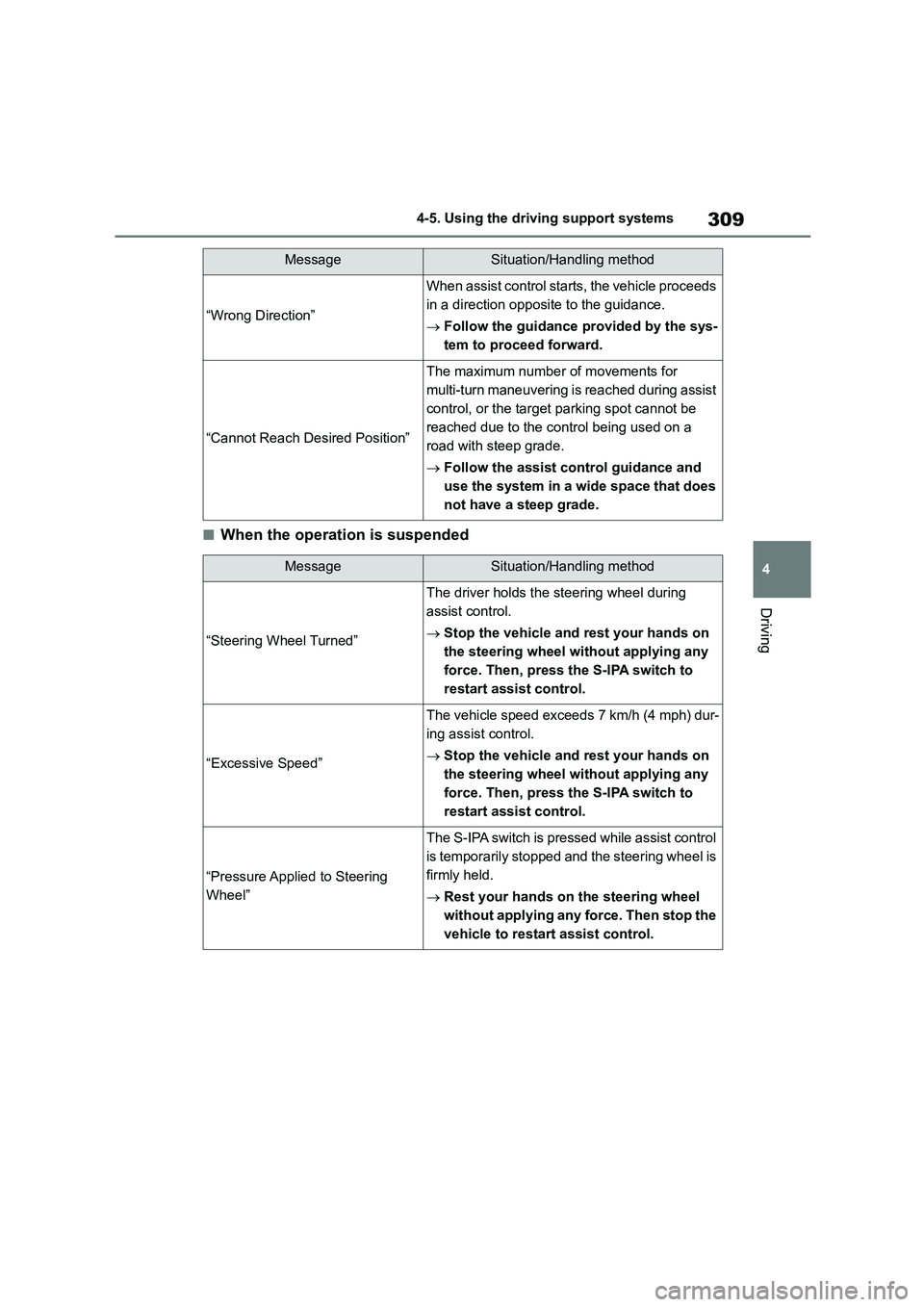
309
4
4-5. Using the driving support systems
Driving
■When the operation is suspended
“Wrong Direction”
When assist control starts, the vehicle proceeds
in a direction opposite to the guidance.
Follow the guidance provided by the sys-
tem to proceed forward.
“Cannot Reach Desired Position”
The maximum number of movements for
multi-turn maneuvering is reached during assist
control, or the target parking spot cannot be
reached due to the control being used on a
road with steep grade.
Follow the assist control guidance and
use the system in a wide space that does
not have a steep grade.
MessageSituation/Handling method
“Steering Wheel Turned”
The driver holds the steering wheel during
assist control.
Stop the vehicle and rest your hands on
the steering wheel without applying any
force. Then, press the S-IPA switch to
restart assist control.
“Excessive Speed”
The vehicle speed exceeds 7 km/h (4 mph) dur-
ing assist control.
Stop the vehicle and rest your hands on
the steering wheel without applying any
force. Then, press the S-IPA switch to
restart assist control.
“Pressure Applied to Steering
Wheel”
The S-IPA switch is pressed while assist control
is temporarily stopped and the steering wheel is
firmly held.
Rest your hands on the steering wheel
without applying any force. Then stop the
vehicle to restart assist control.
MessageSituation/Handling method
Page 312 of 678
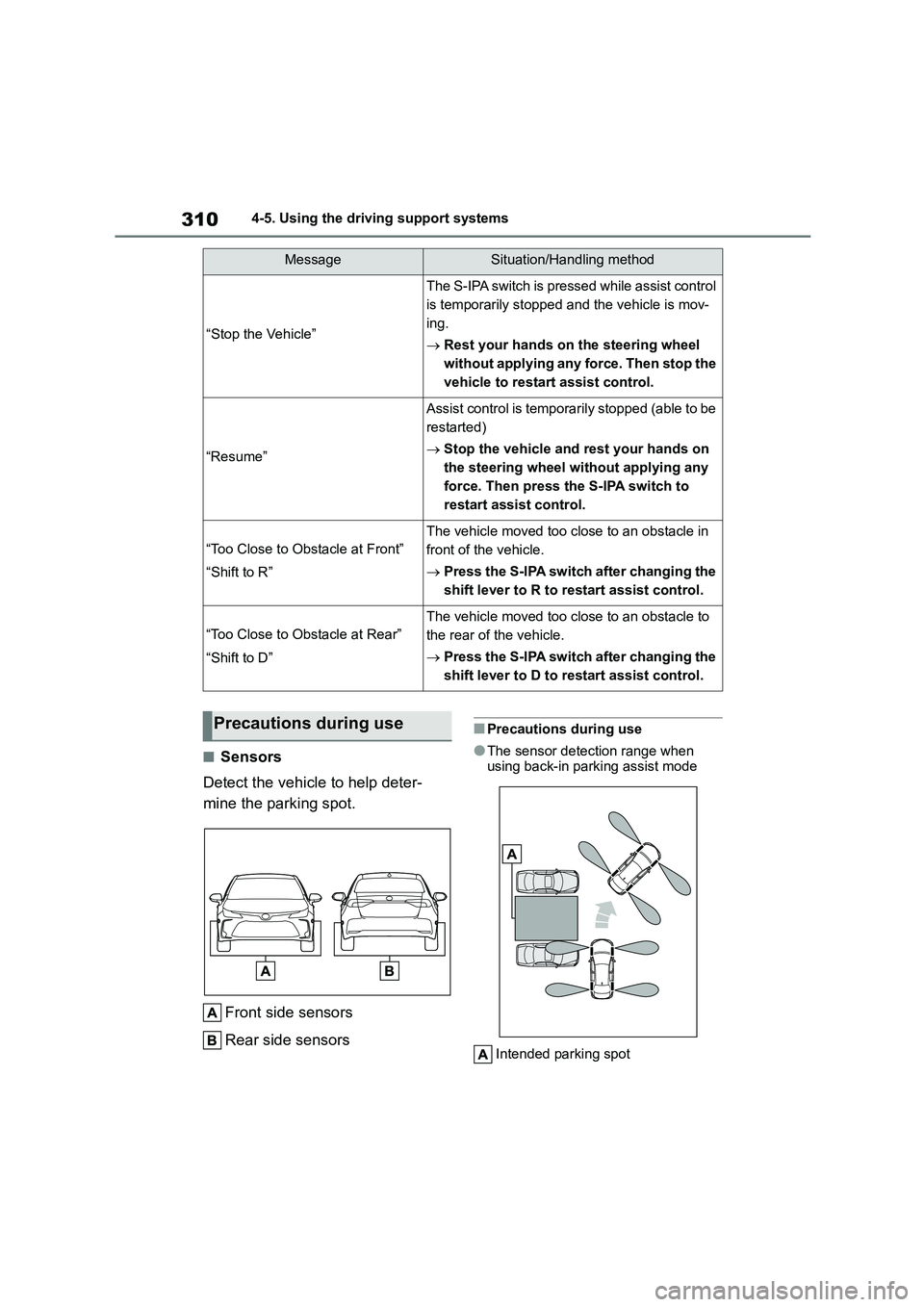
3104-5. Using the driving support systems
■Sensors
Detect the vehicle to help deter-
mine the parking spot.
Front side sensors
Rear side sensors
■Precautions during use
●The sensor detection range when
using back-in parking assist mode
Intended parking spot
“Stop the Vehicle”
The S-IPA switch is pressed while assist control
is temporarily stopped and the vehicle is mov-
ing.
Rest your hands on the steering wheel
without applying any force. Then stop the
vehicle to restart assist control.
“Resume”
Assist control is temporarily stopped (able to be
restarted)
Stop the vehicle and rest your hands on
the steering wheel without applying any
force. Then press the S-IPA switch to
restart assist control.
“Too Close to Obstacle at Front”
“Shift to R”
The vehicle moved too close to an obstacle in
front of the vehicle.
Press the S-IPA switch after changing the
shift lever to R to restart assist control.
“Too Close to Obstacle at Rear”
“Shift to D”
The vehicle moved too close to an obstacle to
the rear of the vehicle.
Press the S-IPA switch after changing the
shift lever to D to restart assist control.
MessageSituation/Handling method
Precautions during use
Page 313 of 678
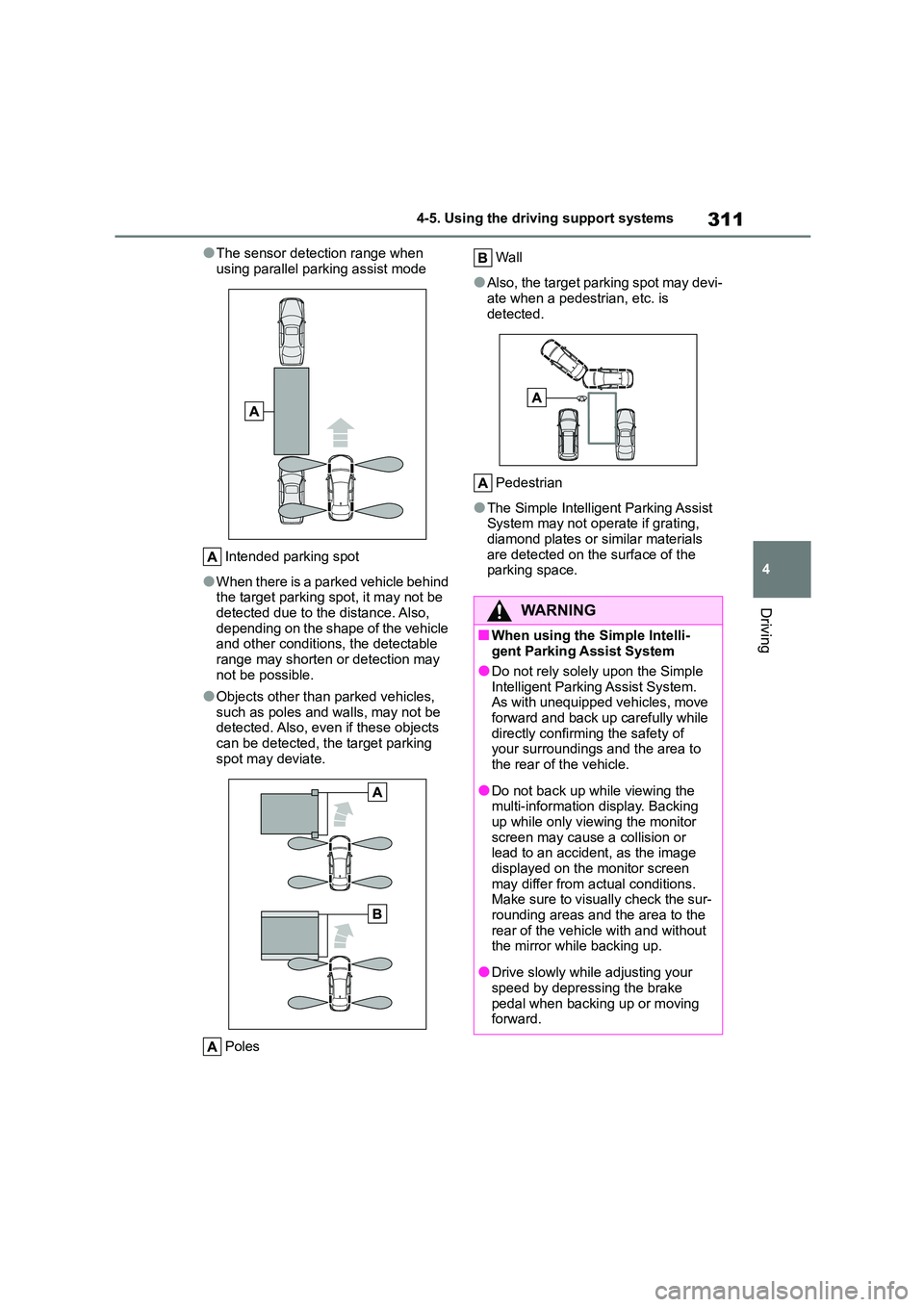
311
4
4-5. Using the driving support systems
Driving
●The sensor detection range when
using parallel parking assist mode
Intended parking spot
●When there is a parked vehicle behind
the target parking spot, it may not be
detected due to the distance. Also, depending on the shape of the vehicle
and other conditions, the detectable
range may shorten or detection may not be possible.
●Objects other than parked vehicles, such as poles and walls, may not be
detected. Also, even if these objects
can be detected, the target parking spot may deviate.
Poles
Wall
●Also, the target parking spot may devi- ate when a pedestrian, etc. is
detected.
Pedestrian
●The Simple Intelligent Parking Assist
System may not operate if grating, diamond plates or similar materials
are detected on the surface of the
parking space.
WA R N I N G
■When using the Simple Intelli- gent Parking Assist System
●Do not rely solely upon the Simple
Intelligent Parking Assist System. As with unequipped vehicles, move
forward and back up carefully while
directly confirming the safety of your surroundings and the area to
the rear of the vehicle.
●Do not back up while viewing the
multi-information display. Backing
up while only viewing the monitor screen may cause a collision or
lead to an accident, as the image
displayed on the monitor screen may differ from actual conditions.
Make sure to visually check the sur-
rounding areas and the area to the rear of the vehicle with and without
the mirror while backing up.
●Drive slowly while adjusting your
speed by depressing the brake
pedal when backing up or moving forward.
Page 314 of 678
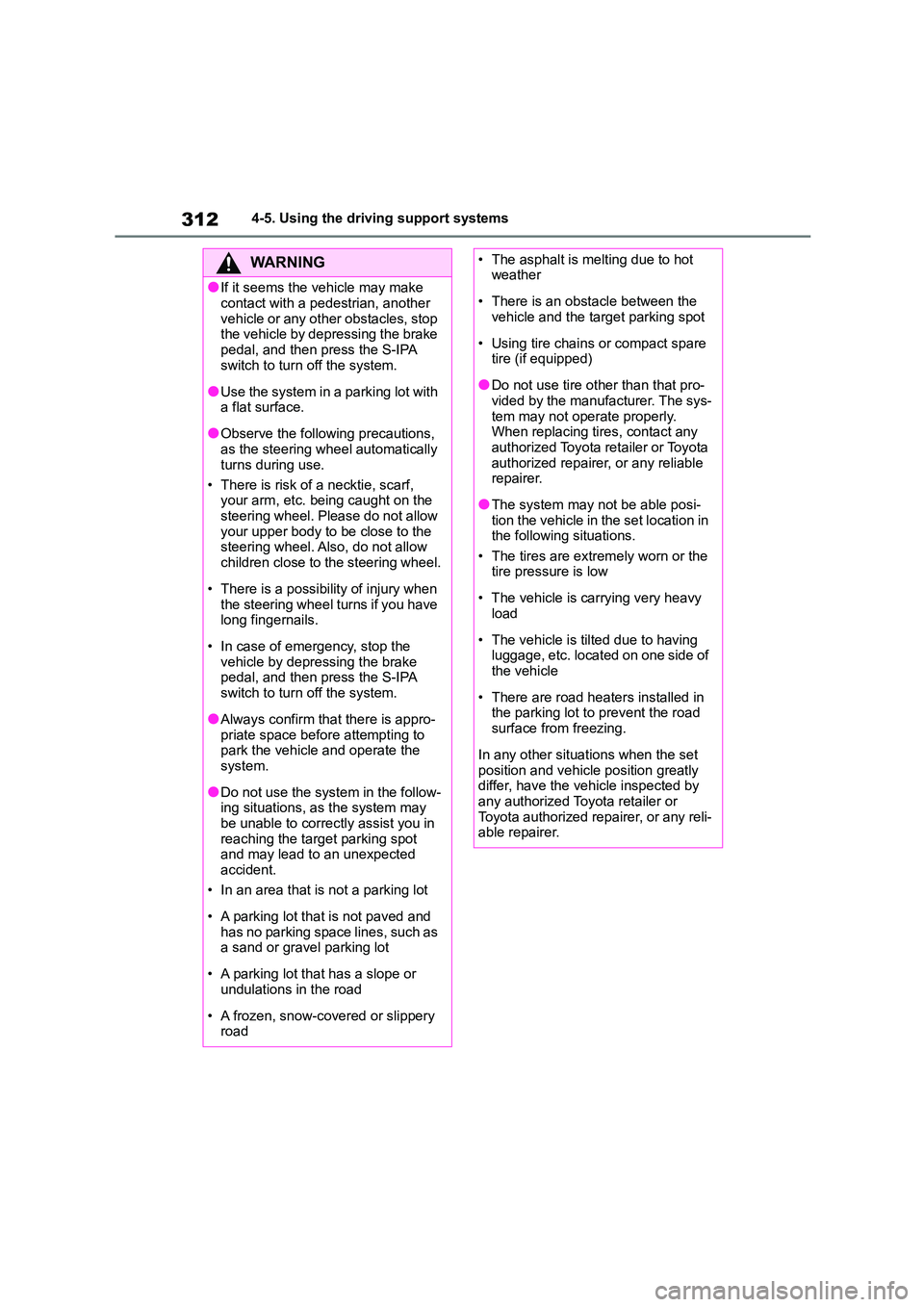
3124-5. Using the driving support systems
WA R N I N G
●If it seems the vehicle may make
contact with a pedestrian, another
vehicle or any other obstacles, stop the vehicle by depressing the brake
pedal, and then press the S-IPA
switch to turn off the system.
●Use the system in a parking lot with
a flat surface.
●Observe the following precautions,
as the steering wheel automatically
turns during use.
• There is risk of a necktie, scarf,
your arm, etc. being caught on the
steering wheel. Please do not allow your upper body to be close to the
steering wheel. Also, do not allow
children close to the steering wheel.
• There is a possibility of injury when
the steering wheel turns if you have long fingernails.
• In case of emergency, stop the vehicle by depressing the brake
pedal, and then press the S-IPA
switch to turn off the system.
●Always confirm that there is appro-
priate space before attempting to park the vehicle and operate the
system.
●Do not use the syst em in the follow-
ing situations, as the system may
be unable to correctly assist you in reaching the target parking spot
and may lead to an unexpected
accident.
• In an area that is not a parking lot
• A parking lot that is not paved and has no parking space lines, such as
a sand or gravel parking lot
• A parking lot that has a slope or
undulations in the road
• A frozen, snow-covered or slippery
road
• The asphalt is melting due to hot weather
• There is an obstacle between the vehicle and the target parking spot
• Using tire chains or compact spare tire (if equipped)
●Do not use tire other than that pro-vided by the manufacturer. The sys-
tem may not operate properly.
When replacing tires, contact any authorized Toyota retailer or Toyota
authorized repairer, or any reliable
repairer.
●The system may not be able posi-
tion the vehicle in the set location in the following situations.
• The tires are extremely worn or the
tire pressure is low
• The vehicle is carrying very heavy
load
• The vehicle is tilted due to having
luggage, etc. located on one side of the vehicle
• There are road heaters installed in the parking lot to prevent the road
surface from freezing.
In any other situations when the set
position and vehicle position greatly
differ, have the vehicle inspected by any authorized Toyota retailer or
Toyota authorized repairer, or any reli-
able repairer.
Page 315 of 678
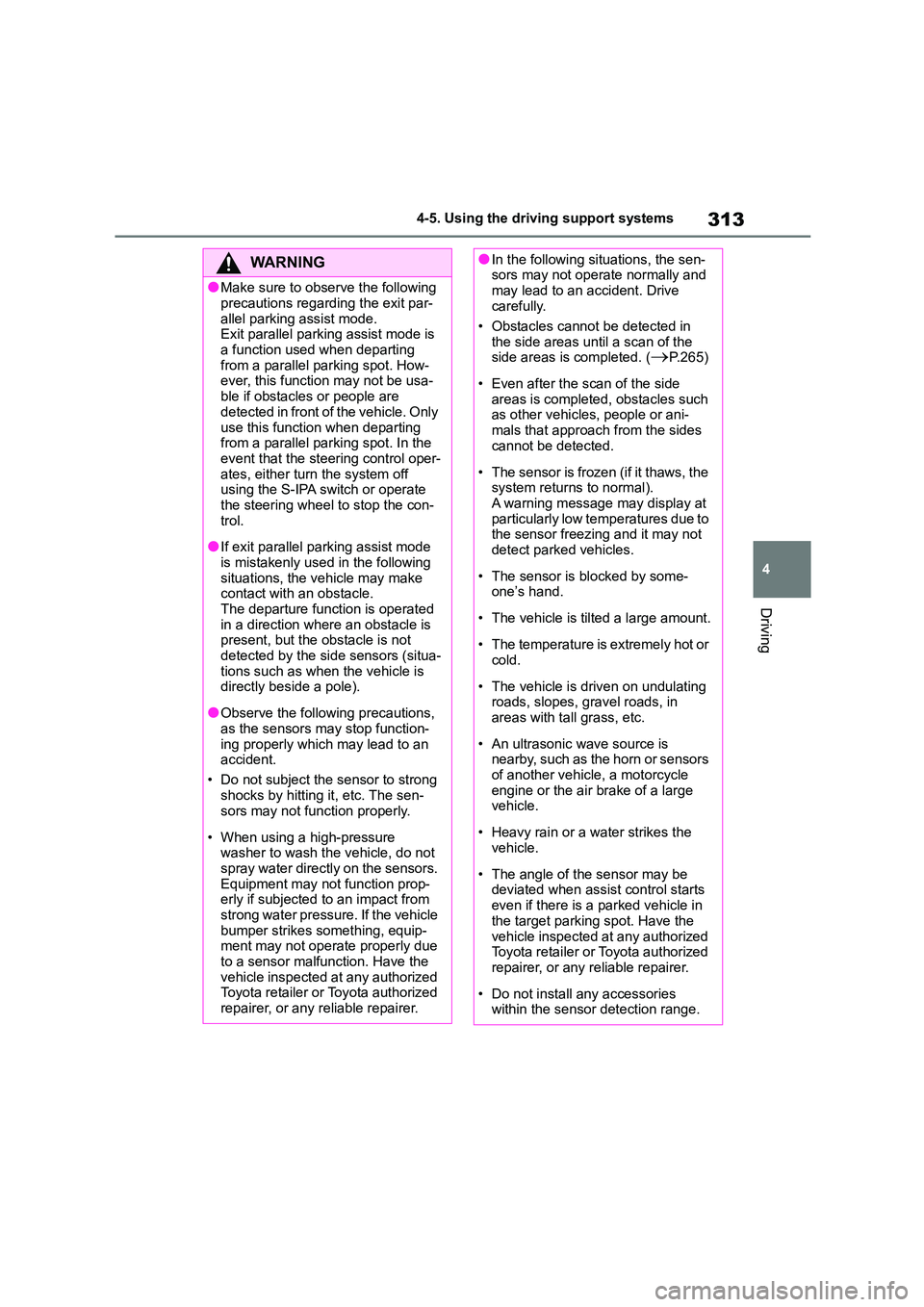
313
4
4-5. Using the driving support systems
Driving
WA R N I N G
●Make sure to observe the following
precautions regarding the exit par-
allel parking assist mode. Exit parallel parking assist mode is
a function used when departing
from a parallel parking spot. How- ever, this function may not be usa-
ble if obstacles or people are
detected in front of the vehicle. Only
use this function when departing from a parallel parking spot. In the
event that the steering control oper-
ates, either turn the system off using the S-IPA switch or operate
the steering wheel to stop the con-
trol.
●If exit parallel parking assist mode
is mistakenly used in the following situations, the vehicle may make
contact with an obstacle.
The departure function is operated in a direction where an obstacle is
present, but the obstacle is not
detected by the side sensors (situa- tions such as when the vehicle is
directly beside a pole).
●Observe the following precautions,
as the sensors may stop function-
ing properly which may lead to an accident.
• Do not subject the sensor to strong
shocks by hitting it, etc. The sen- sors may not function properly.
• When using a high-pressure washer to wash the vehicle, do not
spray water directly on the sensors.
Equipment may not function prop- erly if subjected to an impact from
strong water pressure. If the vehicle
bumper strikes something, equip- ment may not operate properly due
to a sensor malfunction. Have the
vehicle inspected at any authorized Toyota retailer or Toyota authorized
repairer, or any reliable repairer.
●In the following situations, the sen- sors may not operate normally and
may lead to an accident. Drive
carefully.
• Obstacles cannot be detected in
the side areas until a scan of the
side areas is completed. (P.265)
• Even after the scan of the side
areas is completed, obstacles such as other vehicles, people or ani-
mals that approach from the sides
cannot be detected.
• The sensor is frozen (if it thaws, the
system returns to normal). A warning message may display at
particularly low temperatures due to
the sensor freezing and it may not detect parked vehicles.
• The sensor is blocked by some- one’s hand.
• The vehicle is tilted a large amount.
• The temperature is extremely hot or
cold.
• The vehicle is driven on undulating
roads, slopes, gravel roads, in areas with tall grass, etc.
• An ultrasonic wave source is nearby, such as the horn or sensors
of another vehicle, a motorcycle
engine or the air brake of a large vehicle.
• Heavy rain or a water strikes the vehicle.
• The angle of the sensor may be deviated when assist control starts
even if there is a parked vehicle in
the target parking spot. Have the
vehicle inspected at any authorized Toyota retailer or Toyota authorized
repairer, or any reliable repairer.
• Do not install any accessories
within the sensor detection range.
Page 316 of 678
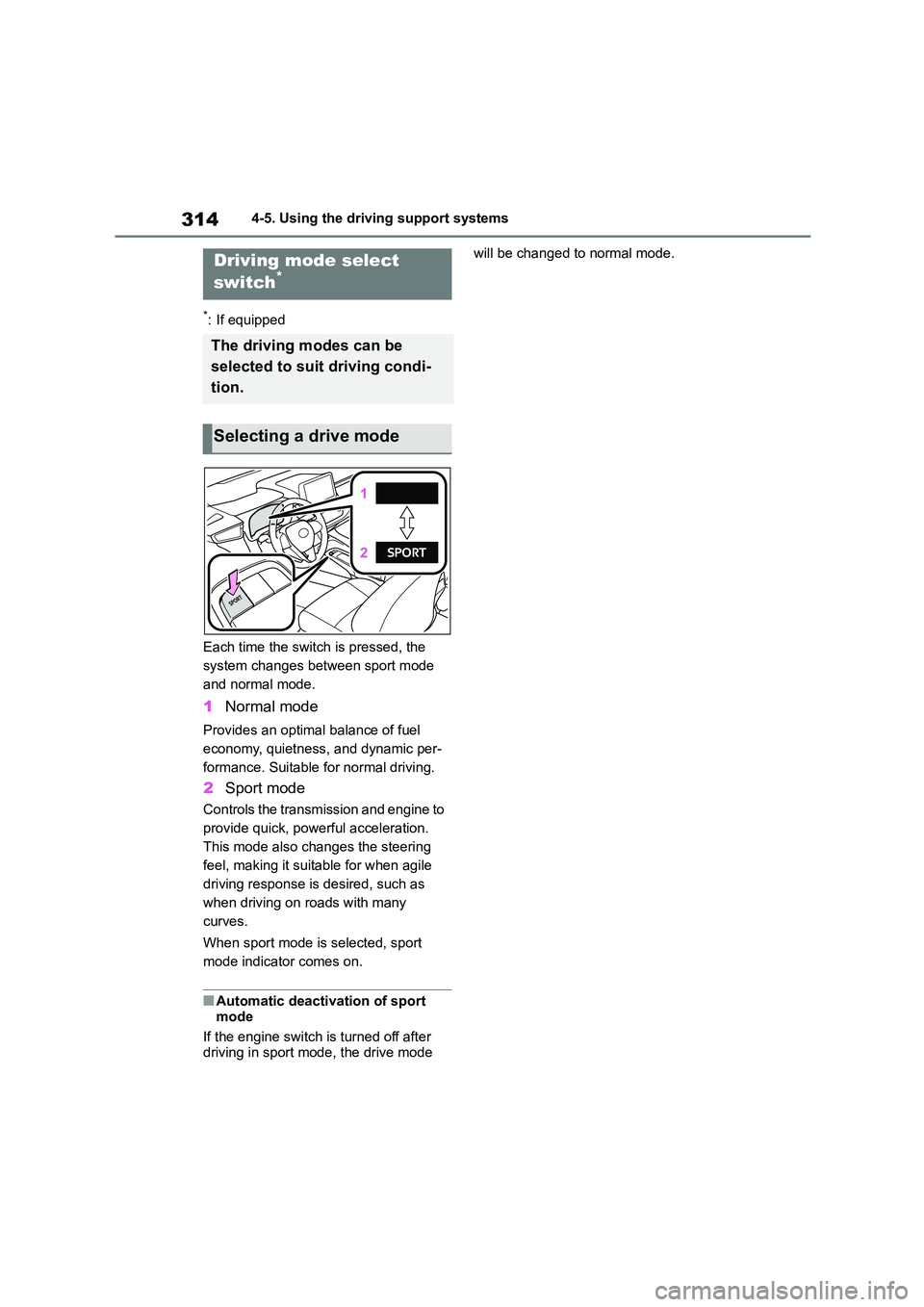
3144-5. Using the driving support systems
*: If equipped
Each time the switch is pressed, the
system changes betw een sport mode
and normal mode.
1 Normal mode
Provides an optimal balance of fuel
economy, quietness, and dynamic per-
formance. Suitable for normal driving.
2 Sport mode
Controls the transmission and engine to
provide quick, powerful acceleration.
This mode also changes the steering
feel, making it suitable for when agile
driving response is desired, such as
when driving on roads with many
curves.
When sport mode is selected, sport
mode indicator comes on.
■Automatic deactivation of sport
mode
If the engine switch is turned off after
driving in sport mode, the drive mode
will be changed to normal mode.Driving mode select
switch*
The driving modes can be
selected to suit driving condi-
tion.
Selecting a drive mode
Page 317 of 678
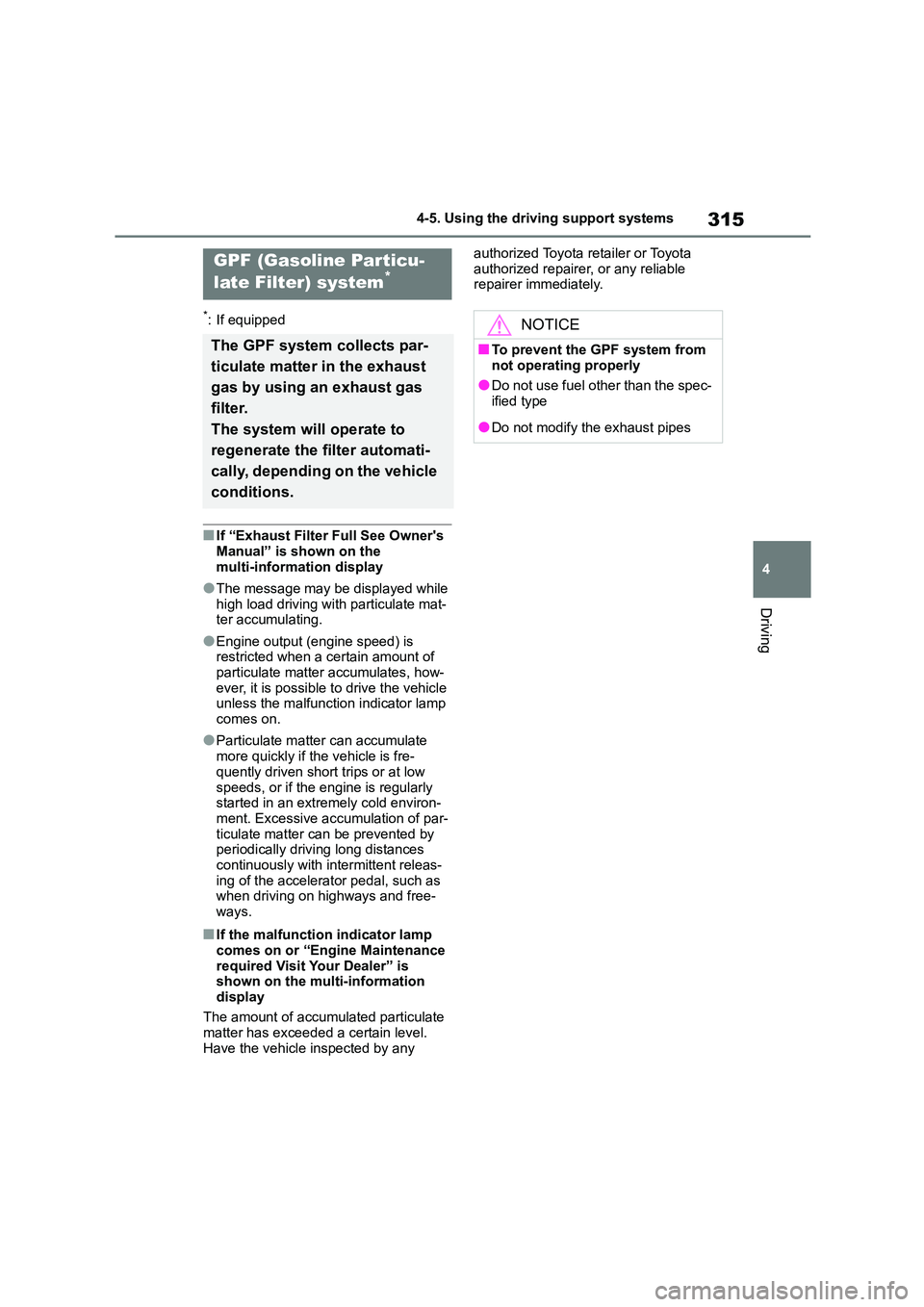
315
4
4-5. Using the driving support systems
Driving
*: If equipped
■If “Exhaust Filter Full See Owner's
Manual” is shown on the
multi-information display
●The message may be displayed while
high load driving with particulate mat- ter accumulating.
●Engine output (engine speed) is restricted when a certain amount of
particulate matter accumulates, how-
ever, it is possible to drive the vehicle unless the malfunction indicator lamp
comes on.
●Particulate matter can accumulate
more quickly if the vehicle is fre-
quently driven short trips or at low
speeds, or if the engine is regularly started in an extremely cold environ-
ment. Excessive accumulation of par-
ticulate matter can be prevented by periodically driving long distances
continuously with intermittent releas-
ing of the accelerator pedal, such as when driving on highways and free-
ways.
■If the malfunction indicator lamp
comes on or “Engine Maintenance required Visit Your Dealer” is
shown on the multi-information
display
The amount of accumulated particulate
matter has exceeded a certain level.
Have the vehicle inspected by any
authorized Toyota retailer or Toyota
authorized repairer, or any reliable repairer immediately.
GPF (Gasoline Particu-
late Filter) system*
The GPF system collects par-
ticulate matter in the exhaust
gas by using an exhaust gas
filter.
The system will operate to
regenerate the filter automati-
cally, depending on the vehicle
conditions.
NOTICE
■To prevent the GPF system from
not operating properly
●Do not use fuel other than the spec-
ified type
●Do not modify the exhaust pipes
Page 318 of 678
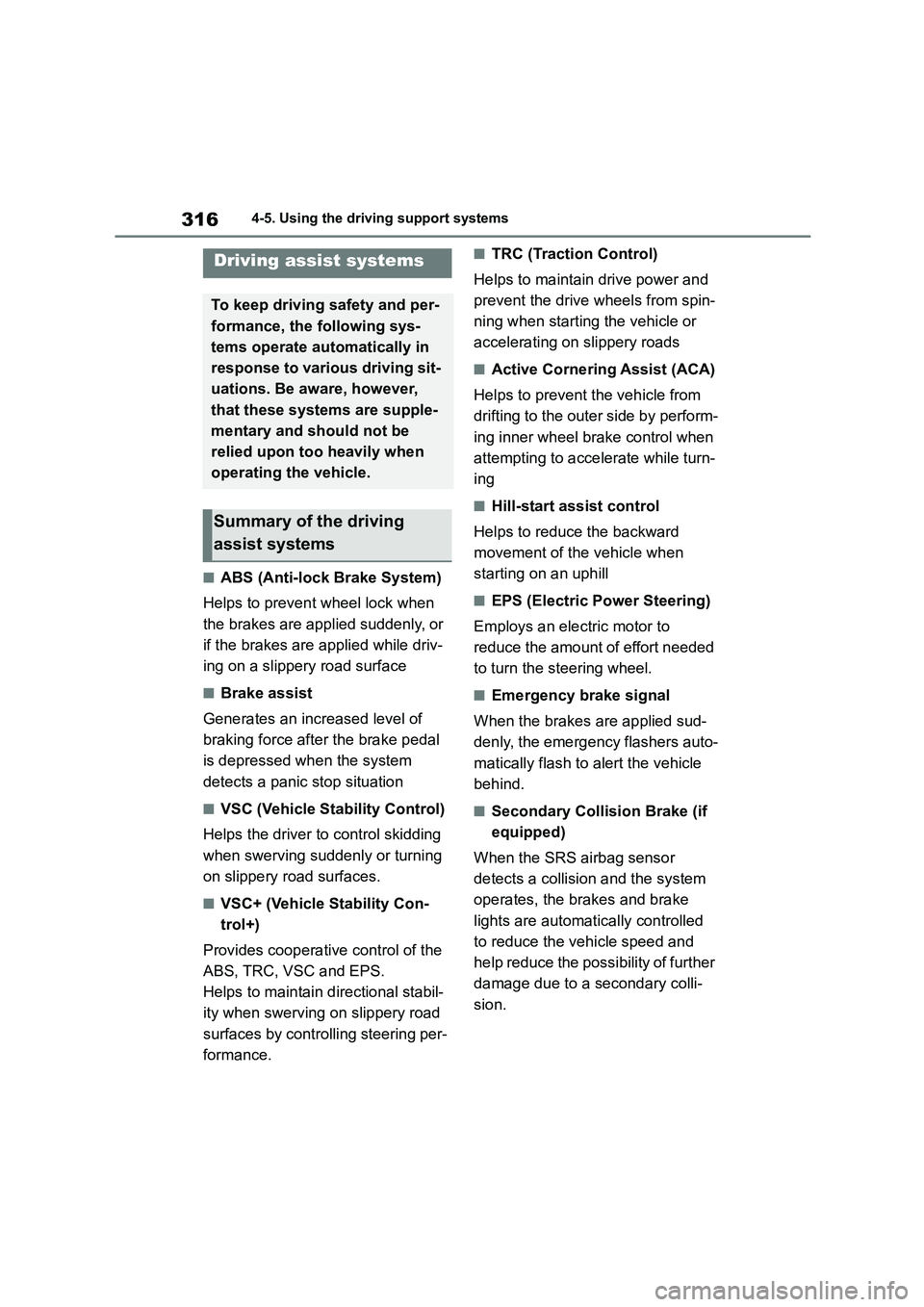
3164-5. Using the driving support systems
■ABS (Anti-lock Brake System)
Helps to prevent wheel lock when
the brakes are applied suddenly, or
if the brakes are applied while driv-
ing on a slippery road surface
■Brake assist
Generates an increased level of
braking force after the brake pedal
is depressed when the system
detects a panic stop situation
■VSC (Vehicle St ability Control)
Helps the driver to control skidding
when swerving suddenly or turning
on slippery road surfaces.
■VSC+ (Vehicle Stability Con-
trol+)
Provides cooperative control of the
ABS, TRC, VSC and EPS.
Helps to maintain directional stabil-
ity when swerving on slippery road
surfaces by controlling steering per-
formance.
■TRC (Traction Control)
Helps to maintain drive power and
prevent the drive wheels from spin-
ning when starting the vehicle or
accelerating on slippery roads
■Active Cornering Assist (ACA)
Helps to prevent the vehicle from
drifting to the outer side by perform-
ing inner wheel brake control when
attempting to acce lerate while turn-
ing
■Hill-start assist control
Helps to reduce the backward
movement of the vehicle when
starting on an uphill
■EPS (Electric Po wer Steering)
Employs an electric motor to
reduce the amount of effort needed
to turn the steering wheel.
■Emergency brake signal
When the brakes are applied sud-
denly, the emergency flashers auto-
matically flash to alert the vehicle
behind.
■Secondary Collision Brake (if
equipped)
When the SRS airbag sensor
detects a collisi on and the system
operates, the brakes and brake
lights are automatically controlled
to reduce the vehicle speed and
help reduce the poss ibility of further
damage due to a secondary colli-
sion.
Driving assist systems
To keep driving safety and per-
formance, the following sys-
tems operate au tomatically in
response to various driving sit-
uations. Be aware, however,
that these systems are supple-
mentary and should not be
relied upon too heavily when
operating the vehicle.
Summary of the driving
assist systems
Page 319 of 678
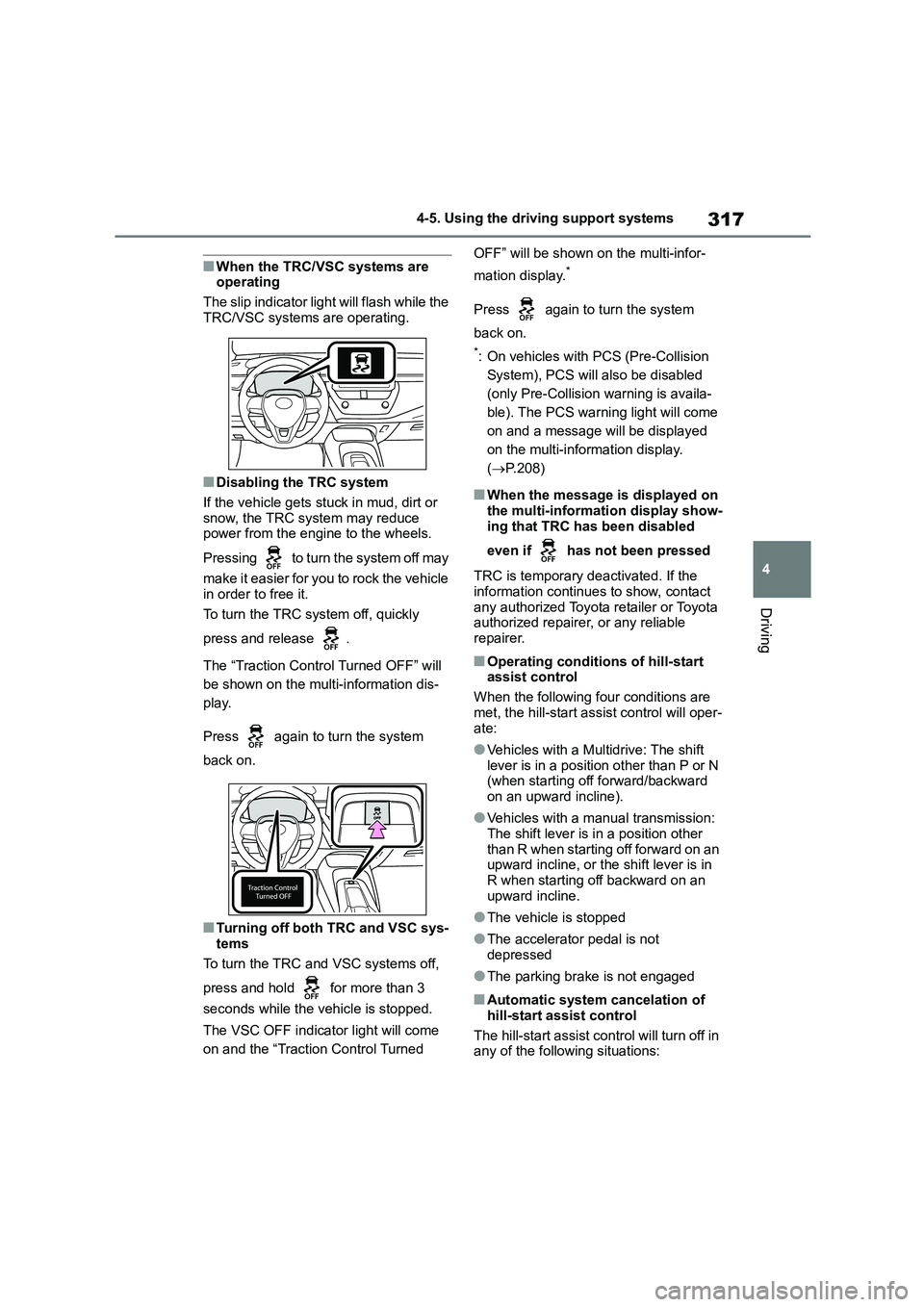
317
4
4-5. Using the driving support systems
Driving
■When the TRC/VSC systems are operating
The slip indicator light will flash while the
TRC/VSC systems are operating.
■Disabling the TRC system
If the vehicle gets stuck in mud, dirt or snow, the TRC system may reduce
power from the engine to the wheels.
Pressing to turn the system off may
make it easier for you to rock the vehicle
in order to free it.
To turn the TRC system off, quickly
press and release .
The “Traction Control Turned OFF” will
be shown on the multi-information dis-
play.
Press again to turn the system
back on.
■Turning off both TRC and VSC sys-
tems
To turn the TRC and VSC systems off,
press and hold for more than 3
seconds while the vehicle is stopped.
The VSC OFF indicator light will come
on and the “Traction Control Turned
OFF” will be shown on the multi-infor-
mation display.*
Press again to turn the system
back on.
*: On vehicles with PCS (Pre-Collision
System), PCS will also be disabled
(only Pre-Collision warning is availa-
ble). The PCS warning light will come
on and a message will be displayed
on the multi-information display.
( P.208)
■When the message is displayed on
the multi-information display show-
ing that TRC has been disabled
even if has not been pressed
TRC is temporary deactivated. If the
information continues to show, contact any authorized Toyota retailer or Toyota
authorized repairer, or any reliable
repairer.
■Operating conditions of hill-start assist control
When the following four conditions are
met, the hill-start assist control will oper- ate:
●Vehicles with a Multidrive: The shift lever is in a position other than P or N
(when starting off forward/backward
on an upward incline).
●Vehicles with a manual transmission:
The shift lever is in a position other than R when starting off forward on an
upward incline, or the shift lever is in
R when starting off backward on an upward incline.
●The vehicle is stopped
●The accelerator pedal is not
depressed
●The parking brake is not engaged
■Automatic system cancelation of
hill-start assist control
The hill-start assist control will turn off in any of the following situations:
Page 320 of 678
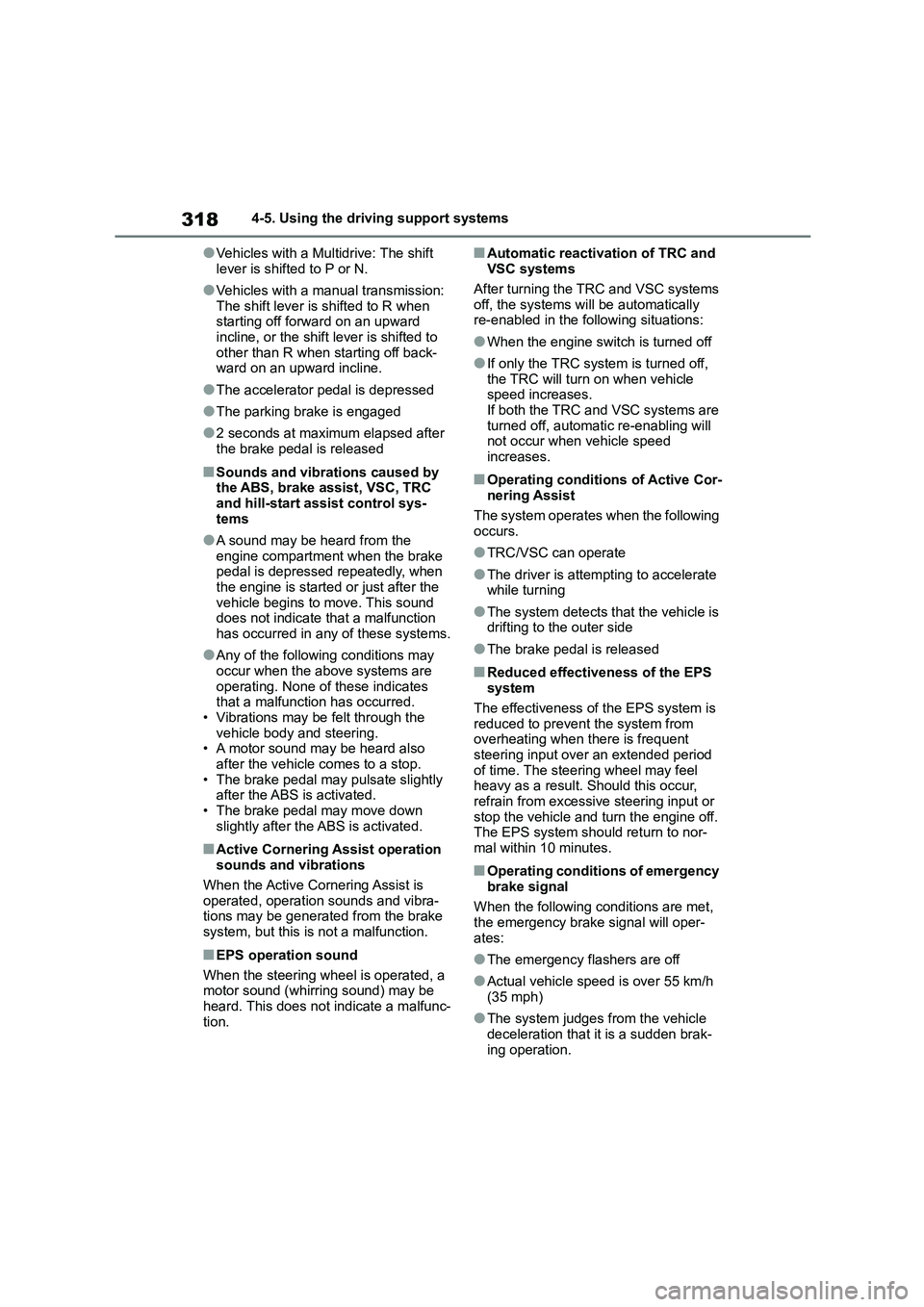
3184-5. Using the driving support systems
●Vehicles with a Multidrive: The shift
lever is shifted to P or N.
●Vehicles with a manual transmission:
The shift lever is shifted to R when starting off forward on an upward
incline, or the shift lever is shifted to
other than R when starting off back- ward on an upward incline.
●The accelerator pedal is depressed
●The parking brake is engaged
●2 seconds at maximum elapsed after
the brake pedal is released
■Sounds and vibrations caused by
the ABS, brake assist, VSC, TRC and hill-start assist control sys-
tems
●A sound may be heard from the
engine compartment when the brake
pedal is depressed repeatedly, when the engine is started or just after the
vehicle begins to move. This sound
does not indicate that a malfunction has occurred in any of these systems.
●Any of the following conditions may occur when the above systems are
operating. None of these indicates
that a malfunction has occurred. • Vibrations may be felt through the
vehicle body and steering.
• A motor sound may be heard also after the vehicle comes to a stop.
• The brake pedal may pulsate slightly
after the ABS is activated. • The brake pedal may move down
slightly after the ABS is activated.
■Active Cornering Assist operation
sounds and vibrations
When the Active Cornering Assist is
operated, operation sounds and vibra-
tions may be generated from the brake
system, but this is not a malfunction.
■EPS operation sound
When the steering wheel is operated, a
motor sound (whirring sound) may be
heard. This does not indicate a malfunc- tion.
■Automatic reactivation of TRC and
VSC systems
After turning the TRC and VSC systems
off, the systems will be automatically
re-enabled in the following situations:
●When the engine switch is turned off
●If only the TRC system is turned off,
the TRC will turn on when vehicle
speed increases. If both the TRC and VSC systems are
turned off, automatic re-enabling will
not occur when vehicle speed increases.
■Operating conditions of Active Cor-
nering Assist
The system operates when the following occurs.
●TRC/VSC can operate
●The driver is attempting to accelerate
while turning
●The system detects that the vehicle is
drifting to the outer side
●The brake pedal is released
■Reduced effectiv eness of the EPS
system
The effectiveness of the EPS system is
reduced to prevent the system from
overheating when there is frequent steering input over an extended period
of time. The steering wheel may feel
heavy as a result. Should this occur, refrain from excessive steering input or
stop the vehicle and turn the engine off.
The EPS system should return to nor- mal within 10 minutes.
■Operating conditions of emergency
brake signal
When the following conditions are met,
the emergency brake signal will oper- ates:
●The emergency flashers are off
●Actual vehicle speed is over 55 km/h
(35 mph)
●The system judges from the vehicle
deceleration that it is a sudden brak- ing operation.